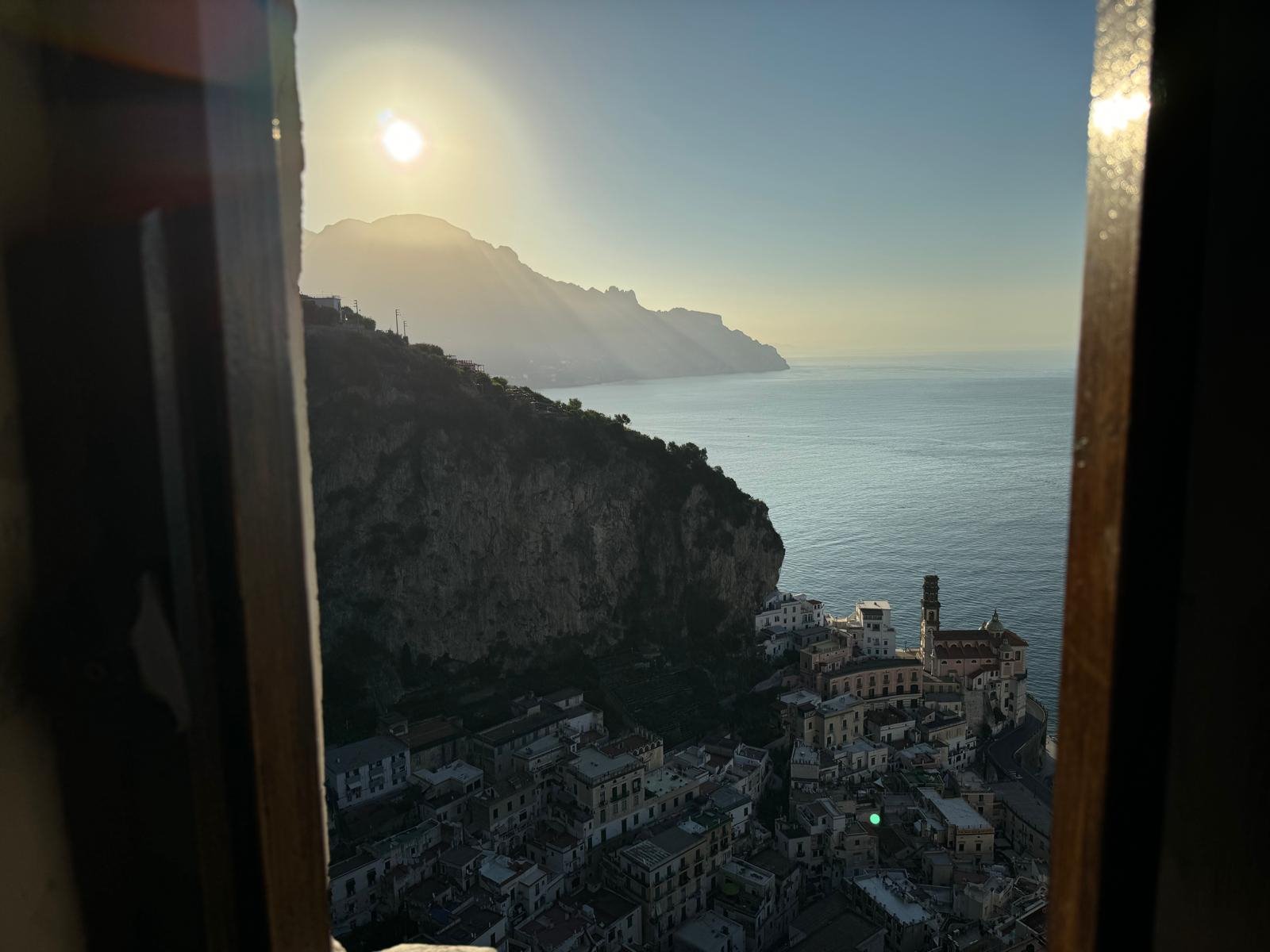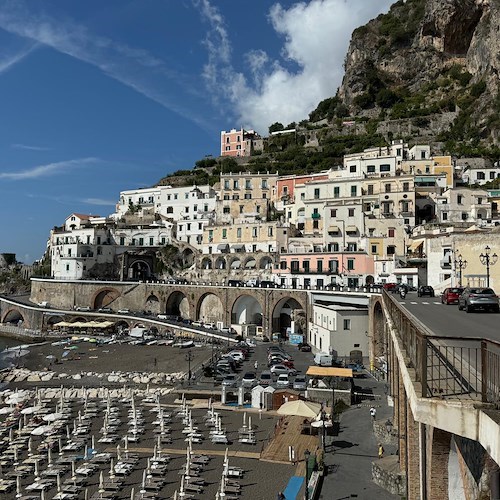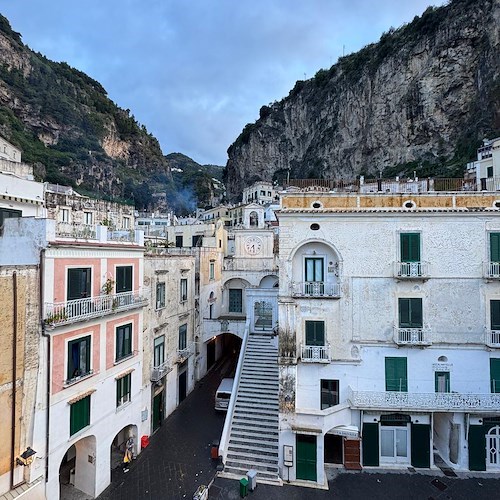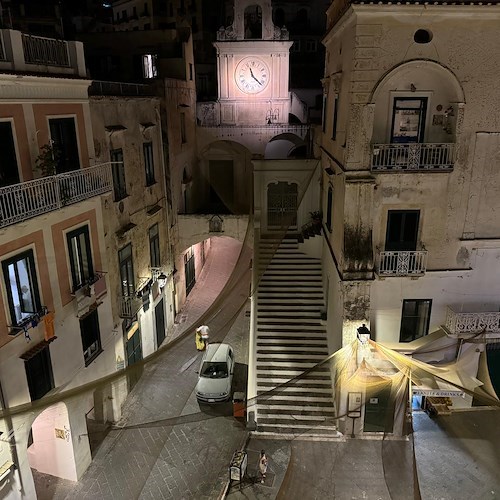You are here: Picturesque townsAtrani: the enchanting village of the Amalfi Coast
Written by (Massimiliano D'Uva), Friday, November 22, 2024 12:39:17 PM

A picturesque fishing village, isolated from the traffic, Atrani is the smallest municipality in the whole Southern Italy. The typical white houses, with balconies full of flowers, form a cascade along the ledges of the surrounding hills (Mount Civita towards East and the Mount Aureo towards West), interspersed with lemon groves, in the valley of the river Dragone, as far as the beach. There are no certain traces about the origins of the town's name: according to some, in fact, it derives from the Latin word "atrum" (dark, with reference to its particular geographical location), according to others from an ancient Greek settlement (Atranes).
From an urban point of view, Atrani preserves a typical medieval town structure with narrow streets and alleys, mostly covered by vaults and arches, which wedge among the houses and then intersect in a square or in a wide stretch. Piazzetta Umberto I, at few steps from the beach and surrounded by a typical block of houses, for its fresh and lively atmosphere brings to mind the well known square in Capri.
Atrani, like all the other towns of the Amalfi Coast, was the residence of noble Roman patricians, evidenced by the sumptuous villas that archaeological excavations are bringing to light. It was mentioned for the first time in a letter of Pope Gregory the Great, in 596.
During the time of the Maritime Republic of Amalfi, Atrani was the residence of local nobles and the ancient Church of San Salvatore de' Birecto was the place were the Doges were crowned with a ducal cap ("birecto").
Among the most important historical and architectural monuments, worth of mention are:
-the Collegiate Church of Santa Maria Maddalena, built in the XIII century on the ruins of an ancient medieval fortress as a vote to thank the Saint for having liberated the area from the Saracen occupation. Rebuilt several times in later centuries, at present it features a Baroque style, with an elegant glazed dome and a square bell tower in dark tufa. Inside important paintings are preserved, including "L'incredulità di San Tommaso", masterpiece of the artist of Salerno, Andrea Sabatini, and valuable sculptures.
-the Church of San Salvatore de' Birecto, built in the X century with a square plan and preceded by an elegant portico. The current façade with the clock and the spectacular staircase was designed during the Baroque period. At the time of the ancient Marine Republic of Amalfi it served as Palatine Chapel: here, in fact, the Doges were elected, crowned and buried. Inside it features a fine marble Byzantine pluteus of the end of the XI century, a tombstone of a noblewoman of Atrani (XIV century), and a portal in bronze, forged in Constantinople in 1087 on request of the nobleman Pantaleone Viaretta, the same who 20 years earlier donated the bronze portal to the Cathedral in Amalfi.
-the small Church of the Immaculate, adjacent to the Church of San Salvatore de' Birecto;
-the Church of the Madonna del Carmine, built in the early XVII century, features a simple façade flanked by a fine bell tower in Moorish style. The interior, characterised by one nave plan with decorated marble floors, preserves an organ with a wooden balcony, a XV century fresco depicting the Madonna on the main altar and, during the Christmas period, it features an XVIII century nativity scene, whose shepherds are a faithful reproduction of the inhabitants of Atrani, at the time when the statuettes were commissioned.
-the Church of Santa Maria del Bando, built in the X century on top of Mount Aureo, under the Torre dello Ziro. The name derives, according to local traditions, to the fact that the Virgin Mary granted the grace of a man unjustly condemned to be hanged, an event depicted in the XV century fresco surmounted on the altar. For the historians, instead, the name derives from the fact that here, in the Republican period, edicts and judgments were proclaimed. Inside a Roman burial urn is preserved.
-The Church of San Michele Arcangelo(XI-XII century), built in a cavity of Mount Civita and used as a cemetery until 1927.
Not to miss:
-Masaniello's Cave on the eastern slope of Mount Aureo, where the famous popular leader (Tommaso Aniello d'Amalfi) sheltered, after the Neapolitan insurrection against the Spanish Government in 1647. The mother's home of the famous revolutionary was historically situated not too far from the cave.
-The Grotto of the Saints, not far from the Torre dello Ziro, decorated with frescoes in Byzantine style. This is all that remains of the ancient Benedictine monastery, entitled to the Saints Quirico and Giulitta, founded by Archbishop Leone I in 986.
 Atrani, estate 2024
© Massimiliano D'Uva
Atrani, estate 2024
© Massimiliano D'Uva
 Atrani, fall 2024
© Massimiliano D'Uva
Atrani, fall 2024
© Massimiliano D'Uva
 Atrani, Amalfi Coast, Italy
© Massimiliano D'Uva
Atrani, Amalfi Coast, Italy
© Massimiliano D'Uva
 Atrani, Santa Maria del Bando, 2024
© Giovanni Proto
Atrani, Santa Maria del Bando, 2024
© Giovanni Proto
rank: 10076101
The beauty of the Amalfi Coast never ceases to amaze, but there are moments when nature seems to outdo itself. This is the case with this stunning aerial shot, taken at dawn by Vietri-born photographer and entrepreneur Carlo De Felice, capturing the magic of the first light of day as it gently touches...
Land between the mountains ("intra montes" in Latin), Tramonti is a wonderful town on the Amalfi Coast, set at the foot of the Lattari Mountains and surrounded by a suggestive bucolic landscape consisting of about 145 acres of woods, terraces cultivated with lemon trees, olive trees, and vineyards. The...
Driving from Salerno, Vietri sul Mare is the first of the 13 pearls of the Amalfi Coast, located in the most sheltered spot of the eponymous gulf. Set at the foot of Monte San Liberatore, it overlooks the valley of the Bonea River. Vietri sul Mare is celebrated worldwide for its vibrant, polychrome ceramic...
A famous residential area for nobles since Roman times, as evidenced by the archaeological discovery of an ancient villa from the 1st century, Minori, the ancient "Reghinna Minor" (to distinguish it from nearby "Reghinna Major," now Maiori), like all other towns of the Amalfi Coast, followed the fortunes...